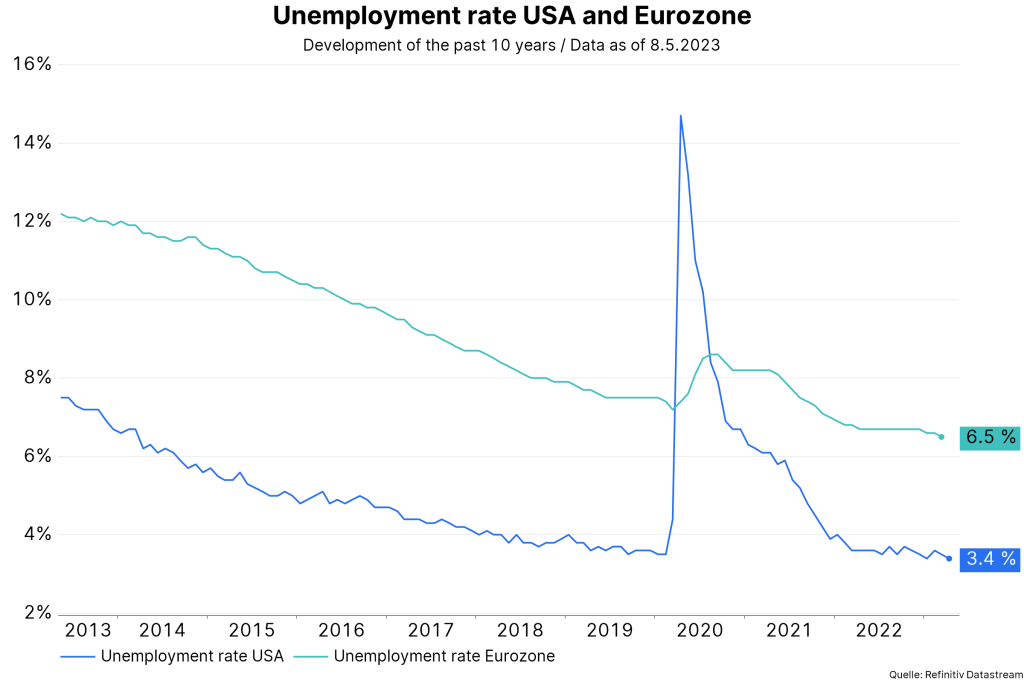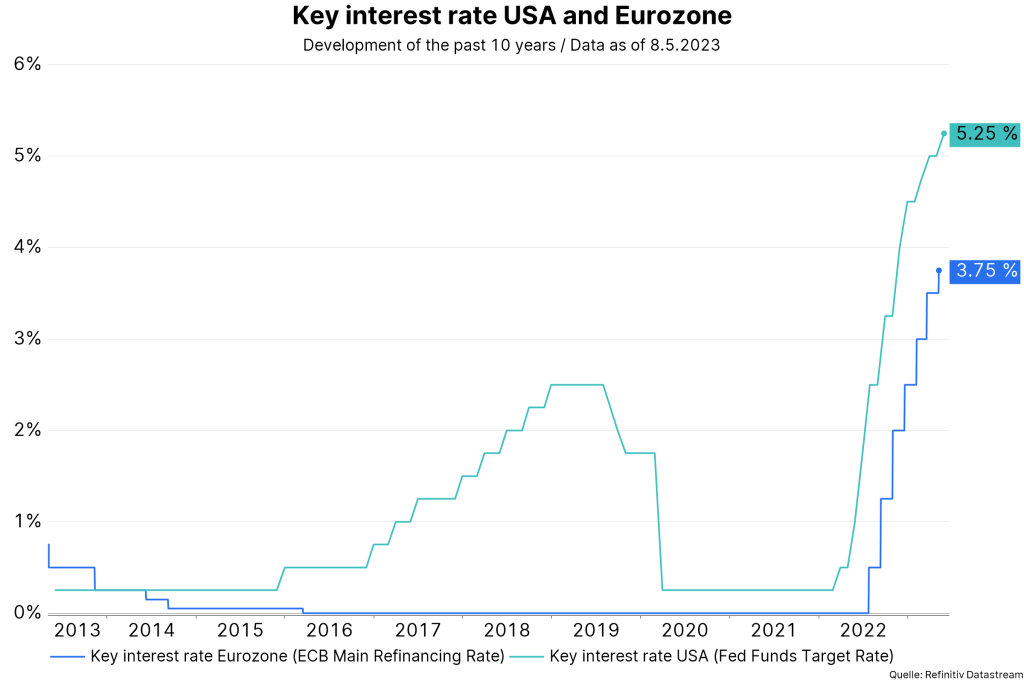Low productivity growth
Data on productivity growth in the USA showed an unfavorable picture. Hours worked, calculated from employment multiplied by average hours, rose strongly by 2.3% year-on-year. Because economic output rose by only 1.3% at the same time, productivity fell by a rounded one percentage point (negative productivity growth).
Compensation per hour worked increased by 4.8%, which is why unit labor costs, calculated as compensation minus productivity growth, rose by 5.8%. The development of unit labor costs is the most important determinant of inflation in the long run. Since 1960, unit labor costs have grown at an average annual rate of 2.9%, while the core rate of personal consumption expenditure inflation (core PCE deflator) has risen by 3.2%.
Firm labor market
Overall, the labor markets remain very firm, i.e. in disequilibrium. In the USA, the unemployment rate was very low at 3.4% in the month of April. The Congressional Budget Offict estimates that full employment without inflationary pressures is one percentage point higher. At the same time, the JOLTS report for the month of March continued to show a very high ratio of job openings to unemployed, but the trend is downward. A soft landing for the economy equates to a significant decline in job openings without a sharp increase in the unemployment rate.
Granted, so far the data are pointing in the right direction, but the risk of a sharp rise in the unemployment rate, synonymous with a recession, remains elevated. This is because the central bank is trying to reduce inflation with a restrictive monetary policy. The situation is similar in the euro zone. In March, the unemployment rate reached a new historic low of 6.5%. At the same time, the gross domestic product in the first quarter grew by only 0.1% quarter-on-quarter and 1.3% year-on-year. A soft landing in the euro zone is possible, but the restrictive monetary policy underscores the downside risks.

Positive growth momentum
The global Purchasing Managers’ Index for April rose for the fourth month in a row. With a value of 54.2, the index is well above the theoretical threshold of 50 that distinguishes expansion from contraction. Translated to real global GDP, the index implies growth of around 3% annualized (that is, annualized). In this context, the difference between the weak manufacturing sector and the strengthening in the services sector is widening. It is striking that in the manufacturing sector, new orders are shrinking slightly and employment is only slightly above the 50 mark. In contrast, in the services sector both indicators show an upward trend and are clearly in growth territory.
The development of selling prices also fits in with this: Falling but still slightly in the growth range in the manufacturing sector, rising and clearly in the growth range in the services sector. An important question regarding future development is whether this gap will be closed via a recovery in the manufacturing sector or a slowdown in the service sector. On the positive side, the report contradicts fears for an immediate recession. Unfortunately, this also dampens hopes for a rapid decline in inflation.
Pause in the rate hike cycle
Despite uncomfortably high inflation, more and more central banks are signaling a pause in the rate hike cycle to better assess the effects of previous rapid rate hikes. In the U.S., the Fed raised the key interest rate further by 0.25 percentage points. The upper band for the effective key interest rate is now at 5.25%. The forward guidance, according to which the Fed expects that further key rate hikes may be appropriate, was dropped. A slight bias for further hikes was maintained, but overall, statement and press conference signal a pause.
However, a pause does not mean the end in the rate hike cycle, as last week’s surprise rate hike by the Reserve Bank of Australia demonstrated. Moreover, high inflation does not justify key rate cuts for the second half of the year, which are reflected in market prices. The European Central Bank also raised its key interest rates by 0.25 percentage points. The interest rate on the deposit facility is now at 3.25%. The main point to highlight in the ECB’s statement is that the cumulative key rate hikes are transmitted forecully to the monetary and financial environment. Indeed, the latest ECB Bank Lending Survey showed a further tightening of lending standards and a further weakening of credit demand.

More time in achieving the inflation target
Central banks are signaling a somewhat less sharp (hawkish) stance because an effect of the rapid key rate hikes on the monetary and financial environment has already become visible. Monetary policy is expected to have a restrictive effect, but not to become much more restrictive, because this would (once again) increase the risks of recession. This is probably to avoid the classic monetary policy mistake that often the last key rate hikes were too much and unnecessarily triggered a recession.
Inflation is still uncomfortably high, but an overall tight environment could gradually lower inflation. So central banks seem to be taking more time to reach their 2% inflation target. This is even more true when one considers that inflation is a lagging indicator of economic activity. The stumbling block in this story is that central banks may once again misjudge underlying inflation as being lower than it actually is.
For a glossary of technical terms, please visit this link: Fund Glossary | Erste Asset Management
Legal note:
Prognoses are no reliable indicator for future performance.
Legal disclaimer
This document is an advertisement. Unless indicated otherwise, source: Erste Asset Management GmbH. The language of communication of the sales offices is German and the languages of communication of the Management Company also include English.
The prospectus for UCITS funds (including any amendments) is prepared and published in accordance with the provisions of the InvFG 2011 as amended. Information for Investors pursuant to § 21 AIFMG is prepared for the alternative investment funds (AIF) administered by Erste Asset Management GmbH pursuant to the provisions of the AIFMG in conjunction with the InvFG 2011.
The currently valid versions of the prospectus, the Information for Investors pursuant to § 21 AIFMG, and the key information document can be found on the website www.erste-am.com under “Mandatory publications” and can be obtained free of charge by interested investors at the offices of the Management Company and at the offices of the depositary bank. The exact date of the most recent publication of the prospectus, the languages in which the key information document is available, and any other locations where the documents can be obtained are indicated on the website www.erste-am.com. A summary of the investor rights is available in German and English on the website www.erste-am.com/investor-rights and can also be obtained from the Management Company.
The Management Company can decide to suspend the provisions it has taken for the sale of unit certificates in other countries in accordance with the regulatory requirements.
Note: You are about to purchase a product that may be difficult to understand. We recommend that you read the indicated fund documents before making an investment decision. In addition to the locations listed above, you can obtain these documents free of charge at the offices of the referring Sparkassen bank and the offices of Erste Bank der oesterreichischen Sparkassen AG. You can also access these documents electronically at www.erste-am.com.
N.B.: The performance scenarios listed in the key information document are based on a calculation method that is specified in an EU regulation. The future market development cannot be accurately predicted. The depicted performance scenarios merely present potential earnings, but are based on the earnings in the recent past. The actual earnings may be lower than indicated. Our analyses and conclusions are general in nature and do not take into account the individual characteristics of our investors in terms of earnings, taxation, experience and knowledge, investment objective, financial position, capacity for loss, and risk tolerance.
Please note: Past performance is not a reliable indicator of the future performance of a fund. Investments in securities entail risks in addition to the opportunities presented here. The value of units and their earnings can rise and fall. Changes in exchange rates can also have a positive or negative effect on the value of an investment. For this reason, you may receive less than your originally invested amount when you redeem your units. Persons who are interested in purchasing units in investment funds are advised to read the current fund prospectus(es) and the Information for Investors pursuant to § 21 AIFMG, especially the risk notices they contain, before making an investment decision. If the fund currency is different than the investor’s home currency, changes in the relevant exchange rate can positively or negatively influence the value of the investment and the amount of the costs associated with the fund in the home currency.
We are not permitted to directly or indirectly offer, sell, transfer, or deliver this financial product to natural or legal persons whose place of residence or domicile is located in a country where this is legally prohibited. In this case, we may not provide any product information, either.
Please consult the corresponding information in the fund prospectus and the Information for Investors pursuant to § 21 AIFMG for restrictions on the sale of the fund to American or Russian citizens.
It is expressly noted that this communication does not provide any investment recommendations, but only expresses our current market assessment. Thus, this communication is not a substitute for investment advice, does not take into account the legal regulations aimed at promoting the independence of financial analyses, and is not subject to a prohibition on trading following the distribution of financial analyses.
This document does not represent a sales activity of the Management Company and therefore may not be construed as an offer for the purchase or sale of financial or investment instruments.
Erste Asset Management GmbH is affiliated with the referring Sparkassen banks and Erste Bank.
Please also read the “Information about us and our securities services” published by your bank.
Subject to misprints and errors.



